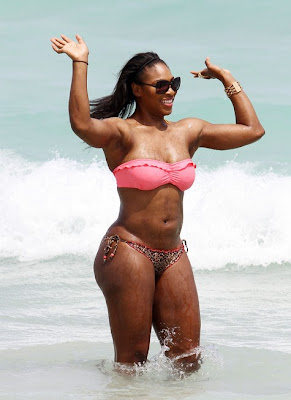Find an old surfboard that is big for your size and floats you well. A good starting size for a 120 lb surfer is 6'10", 7'2" for a 140 lb surfer, and 7'6"+ for a 170 and above surfer. The board should be rented or borrowed from a friend if possible. New boards should not be purchased when learning to surf. Beginners cause a lot of wear and tear on boards, plus the bigger board may become cumbersome as the surfer gains more ability. In addition, new boards loose considerable resale value after they are dinged or shattered a few times. Once the beginner is able to catch a few waves on a regular basis, finding an acceptable design and size will become much easier.
Take the board to an uncrowded beach break to start with. Uncrowded conditions may be difficult to find, so go to the beach early or plan to stay late, when the wind dies down just before dark. Nothing is more upsetting to an experienced surfer than having a beginner paddling around in the surf line on a crowded day. It is also dangerous for the beginner since you may loose your board and have it hit someone else, or have a less experienced surfer not control his board and hit you. Small breaks and shore breaks are usually a haven for beginners, so you will have a lot of company. In all cases, make sure you use your leash.
Paddle your board out to where good rolling soup can carry you towards the shore. You will probably need learn how to move you board around and paddle about in bumpy conditions, so just lay flat with your legs slightly apart straddling the board. When you paddle, place one hand in the water and stroke at a time. When you paddle for a wave, start paddling well before the wave gets to you in order to build up momentum. Also, never paddle in front of another surfer.
To turn gradually while paddling, just lean slightly to the side you want to turn towards. When you get to a small rolling wave, aim the board directly towards it, hold each rail near the nose of the board tightly and do a push up. The soup will wash between you and your board and not bounce you around as bad. Make sure you hold the board near the nose as holding on the sides may result in the board smashing against your face.
At first, walk your board as far out into the surf as you can. When you think that you are far enough out that the soup will push you towards shore, turn the board towards the beach, and let the oncoming wave carry you. If you're sitting on the board, turning it to catch the wave may be difficult at first. Just sit upright towards the tail section and use your hands and feet to paddle in the direction you want to turn. Allow plenty of time to get completely turned before the wave hits. Don't let the wave catch your board sideways, sitting on the board or standing in the water, especially when the board is between you and the wave. The picture shows me riding the soup into shore during a contest.
Don't try to stand up initially. Instead, as the wave carries you towards shore, try to become familiar with how the board responds to leaning forwards, backwards, and to each side. You also need to learn how far forward you can position yourself in order to prevent the board's nose from catching into the wave. Nosing into the wave, called purling, will usually result in your quick exit from the board. Finding the correct balance point to prevent purling is absolutely essential when you take off on an outside wave.
After you have learned to catch waves easily while lying down, you are ready to try standing. When you catch the wave and your momentum builds, hold both rails and push yourself into a standing position. You should stand with one foot about 2 feet in front of the other, near the middle of the board. Put whichever foot is the most comfortable in the forward position. A "goofy" foot has the right foot forward while a "regular" foot has the left foot forward.
Lean lightly forward while keeping your knees slightly bent. The board will shoot out from under you if you lean too far backwards. To turn, lean into the rail and kick your board slightly in the direction you want to go. Holding the same side hand as your leading foot out in front of you slightly will aid in balance and control. Stay in the lower part of the wave's shoulder, frontside (facing the wave), and don't try to turn back at first (cutback). When you feel comfortable frontside, lean back on your rear foot and slowly throw your weight towards the bottom of the wave face. This will initiate a cutback.
































































